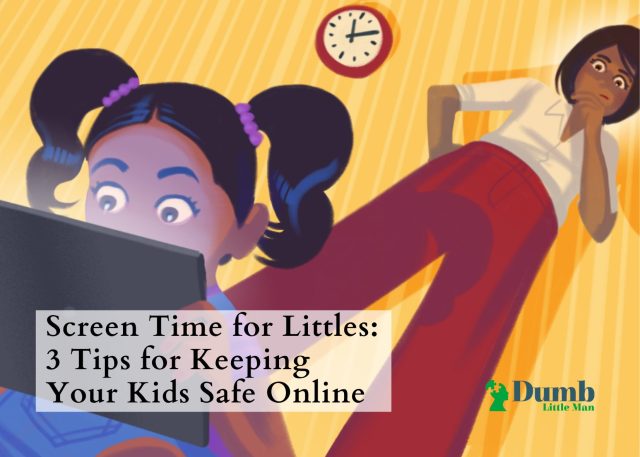Screen Time for Littles: 3 Tips for Keeping Your Kids Safe Online
By Suzanne Barchers
January 10, 2024 • Fact checked by Dumb Little Man

The moment you become a parent, you develop new senses. You can hear a faint cough from miles away. You can read the slightest change in a fibbing kiddo’s body language. You can even see dangers before they happen … at least most of the time.
Here’s the problem, though: It’s easy to let those spidey senses go into hibernation mode when your child is online. Yes, you know the internet is a risky place. But it’s hard to remember that when your kid is sitting in the same room as you. Consequently, you might forget that their safety could be in jeopardy.
Kids who surf the net, engage on social media and explore YouTube routinely stumble across all sorts of precarious situations. They could inadvertently give away passwords and private information. They could chat with strangers who don’t have their best interests at heart. In those moments, you can’t protect them if you haven’t already put preventive roadblocks in place.
In other words, parenting is hard in this digital age. In fact, Pew Research Center reports that 66% of seasoned parents believe that parenting today is tougher than parenting 20 years ago — mostly because of technology. The solution isn’t to totally remove tech from your children’s lives, however. They need to know about the tech-filled world they’ll inevitably inherit. (And you need an easy tool to distract them while waiting for a doctor’s appointment or taking a long car ride.) How, then, do you introduce your children to technology without exposing them to danger?
How to Protect Your Children When They’re Online
The answer begins with a deeper understanding of child development. Most kids have a healthy fear of the unknown. At the same time, though, they’re curious. That’s why they might try to slide downstairs on a box lid or write on the bathroom walls in lipstick. When they get online, they might be nervous, but children don’t have the self-restraint to exercise caution. And — as you probably know — their self-restraint plummets further if they’re hanging out with friends.

This desire to delve into the digital Wild West can lead to exposure to violent or sexualized content or messaging that’s inconsistent with your family values, especially since one-quarter of YouTube videos watched by children under age nine are meant for older audiences, according to research by the University of Michigan C.S. Mott Children’s Hospital and Common Sense Media. Even if kids don’t understand what they’re reading or watching online, they can be confused and even traumatized by the experience.
So, what’s the best way to foster your children’s growth while still playing the role of protector and guide when they’re online? Start with these tips:
1. Look out for signs of exposure to questionable content
Your toddler suddenly says a nasty word you’ve never used. Your teen quickly shuts down the computer as soon as you walk into the room. These red flags might indicate that the material your child is watching isn’t something you’d approve of.
Do a little detective work, then intervene. The last thing you want is to ignore a potential problem. After all, something that seems as “natural” as kids picking on each other can lead to cyberbullying or social pressure to conform. If you spot clues that something isn’t right with your child (such as behavioral changes, tanking grades, overuse of screens, and signs of sadness) then you have every right to stop all online activity.
2. Take control of your child’s internet habits.
Ultimately, you’re in charge of what happens in your household. Although you might feel like your kids are running roughshod over everything, you’re the parent. That means you get to set parameters around what’s safe and appropriate for your kids, as well as for your kids’ friends when they visit.
When you decide your youngster is old enough to use a tablet, phone, or computer, install services and software that act as filters and track your child’s use and history to ensure they’re using appropriate sites. Not sure which products work best? Ask other parents who have been there and done that, or do some research online. Don’t use the excuse that you’ll never be able to figure those controls out. Even if you’re a non-technical person, you can do it.
3. Keep lines of communication open
Sharing is caring, especially when it comes to safer web browsing. Be open about your own beliefs with your children. For example, you might tell your child, “I looked for a new recipe online. The site wanted my email, address, and phone number! I left right away because it made me feel uncomfortable.” Your openness gives your child a chance to talk about things that seem out of place, too.
Not all upfront discussions will be so easygoing, however. You will need to have more serious talks about which games, activities, and sites you trust, and which ones you don’t. Consequently, you’ll need to be able to explain why you’re saying no — and be willing to be the “bad guy” once in a while. (Take note: You’re really the good guy in disguise!)
As a parent, you can never stop being vigilant. It’s a 24/7 job to keep hackers, predators, and inappropriate content out of your kids’ view when they’re online. But your diligence will give you peace of mind and ensure that your children grow up knowing how to gauge what’s safe and what’s not.
Suzanne Barchers
Suzanne Barchers, Ed.D., is the education advisory board chair at Lingokids, an educational platform for children ages 2-8. Suzanne is the former editor-in-chief and vice president of LeapFrog Enterprises and managing editor at Weekly Reader. She is an award-winning author of more than 250 books for teachers and children and served on advisory boards for PBS and the Association of Educational Publishers.

